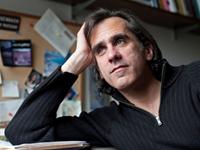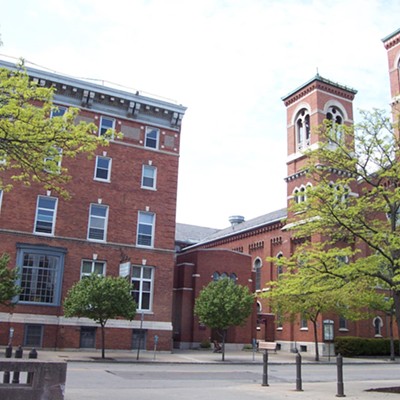Stem cell research: a reader-scientist dialogue
[
{
"name": "500x250 Ad",
"insertPoint": "5",
"component": "15667920",
"parentWrapperClass": "",
"requiredCountToDisplay": "1"
}
]
Tim Louis Macaluso's interview with University of Rochester biologist Mark Noble, published January 4, brought quick response from readers opposed to stem cell research. Their comments, and Noble's response, follow.
Feminists for Life of New York disputes Mark Noble's claim that the controversy surrounding embryonic stem cell research is solely a religious one ("Hope, Fear, and Politics," January 4). In addition to the objections of religious groups, based on their belief that life begins at conception, there are objections from within the scientific community itself. Do No Harm, the Coalition of Americans for Research Ethics, is a group of scientists and physicians who encourage the pursuit of adult stem cell research over embryonic stem cell research because of known successful treatments with ASC verses no known treatments or cures using ESC. This coalition also objects based on concerns that ESC research violates ethical guidelines set in place for conducting research on human subjects.
Feminists for Life of New York objects to ESC research based its potential health, social, and emotional risks for women. For example, what are the long-term effects of super-ovulation drugs on women's health? What population of women will the scientific community call upon for volunteers to participate in creating and harvesting live embryos? Will certain populations be offered compensation to become pregnant for the intent purpose of "embryo harvesting"? If so, what will be the medical, physical and psychological effects on these women?
FFLNY believes that ESC research is unethical. It steals a life at its most vulnerable pointand directs millions of dollars away from ASC research and its many proven therapies and cures.
Kelly Vincent-Brunacini, Rush-Henrietta Town Line Road, Rush (Vincent-Brunacini is a member of the board of Feminists for Life of New York
Tim Macaluso states that the sources of embryonic stem cells are only three: "umbilical cord placenta, aborted fetuses, and unused fertilized eggs from fertility clinics." Never mind the scientific distortion this assumption makes, and save the limitations of frozen embryos for another argument. Macaluso fails to mention what might be the world's most fruitful and economic source of embryonic stem cells: eggs that women "donate" to science. We might have the ability to produce an embryo without sperm, but we can't do it without an egg. Every woman who continues to ovulate, in other words, every woman who still experiences her period, has access to such eggs. She can choose how to use them.
Mark Noble likes to have us imagine scenarios that help determine the value we assign to life, like the one he poses about a fire that forces a choice between saving thousands of human embryos or a single 5-year-old child.
I suggest another scenario, which invites us to determine the value of a woman's body. Which women will be donating the millions of eggs science eventually will require to perform experiments on human embryos? Women inspired by the illness of friends and the hype given possible cures? Women lab assistants whose positions are more secure through their donations? Women driven by guilt, who become pregnant to save family members? Women too poor to pay their bills who sell their monthly ova? Women who can sell even more by using fertility drugs to produce eggs instead of producing children?
The possibilities are endless. Where are the feminists worrying that "my body is myself?"
The recent Korean scandal over stem cell research is a case in point. Not only should it cause us to pause before leaping on to advance such projects, but it should cause us to ask: "where do we want to obtain the eggs?" Veterinarian Hwang Woo Suk's first ethical breach involved the source of eggs. When scientists discovered that Hwang used ova "donated" from two of his junior scientists rather than volunteers, they condemned the practice.
I fear in our rush to obtain funding for research not yet proven ethical or even possible, we might fall into the Korean trap. I offer two suggestions: 1) continue intensive adult stem research, and 2) advance the new research that creates embryonic stem cells without destroying life. Do we all know that's what happening?
Suzanne Schnittman, Highland Avenue, Rochester
Regarding Dr. Mark Noble's "thought experiment" about choosing between rescuing a nitrogen tank containing frozen embryos and a child: is he posing this question to the owners (also known as parents) of the embryos? Their answer might not be as obvious as the one Dr. Noble presumes. I would venture that they would value the child and the nitrogen tank of equal and infinite value. Therefore both are worthy of rescue.
In the discussion of embryonic stem cell research, much is said about using the embryos that "will be discarded anyway." For anything to happen to an embryo, consent is required by the parents. Why haven't we heard from all these parents who are supposedly lining up to donate their "extra" embryos for research? My guess is they are unwilling. Maybe they have witnessed at least one of their embryos as the younger selves of their current children and wouldn't dream of donating them for research; so why donate their siblings? A recent study showed 59 percent of parents who initially planned to discard extra embryos changed their minds later, choosing another pregnancy or donation to infertile couples.
Dr. Noble cites estimations that "between 40 and 80 percent of blastocysts are washed out in the menstrual flow." This language not only seeks to liken early life to waste products, but it is misleading. If these blastocysts are so necessary for embryonic stem cell research, why not collect menstrual blood and extract them? Besides being an inefficient process, the answer is obvious. Blastocysts present in menstrual blood are products of a very early miscarriage. In short, they are not viable. And it is living human embryos, donated with the consent of their parents, which are necessary for ESCR.
Calling those who question embryonic stem cell research anti-science or uninformed is not fair; many of them are the ones who will not be manipulated by language likening embryos to waste and hypothetical scenarios that ultimately only bring out differences in the age of living beings.
Margaret Smerbeck, Pittsford
Mark Noble's response: It would be wonderful if these readers, and those of like mind, lobbied the government to provide $2 billion to more rapidly test the idea that adult-derived stem cells do the wonderful things the readers claim. This amount of funding --- equivalent only to the current expenditure for about one week in Iraq --- would provide critical findings for a discussion that needs to proceed based on real data. At present, however, claims that adult-derived stem cells are all we need have no sound scientific basis.
The continued assertion otherwise by opponents of embryonic stem cell research reflects an ignorance of the science, or an insistence on using false statements to support a particular belief. Neither of these approaches is useful. We in the scientific arena do not now quote the discredited work of the Hwang Woo Suk laboratory, and antagonists of this research need to be similarly dedicated to accuracy.
The quality of human-ness means different things to different people and in different cultures. Some people may believe that a ball of 100 cells that contains no nerve cells, gut cells, muscle cells, or differentiated cells of any kind is equivalent to a living, breathing person. There are many more who, like myself, see clear differences.
Utility is currently unproven for use of adult-derived cells in treating anything other than conditions (almost always cancer-related) in which bone marrow transplants are used to replace cells of the bloodstream. Claims of equivalency of 100-cell blastocysts and living, breathing humans thus need to be very carefully weighed, particularly as I believe we will relatively soon learn to use cells derived from a single such blastocyst to treat dozens or hundreds of living, breathing people.
Even if I accept your claims about blastocyst numbers, this leaves many tens of thousands of excess blastocysts being discarded from fertility clinics every year. Some may think it preferable that these blastocysts be incinerated than to first remove a small number of cells that might prove useful in treatment of serious diseases. I disagree. As for the many women who volunteer to be egg donors in the hopes of advancing medical research, isn't this their prerogative --- and not yours to decide for them?
In addition, the scientific community is working to obtain unfertilized eggs from the many ovaries that are removed for medical reasons, a procedure that would greatly reduce any need for egg donors.
Given the potential of stem cells, opponents of research must ask what right they have to obstruct potentially useful treatments for the millions of children and adults with serious diseases for whom stem cell therapy might change their lives. Moreover, it is ironic that if those opposed to embryonic stem cell research were successful, the most likely effect would be to slow down this particular research --- this at a time when cells derived from fetuses voluntarily aborted for personal reasons of the mother are potentially proving their use in the clinic.
We in the scientific community are trying to progress beyond this stage, while the effects of such obstruction would be to make such fetal cells a valuable market commodity. Wouldn't it be better to conduct the necessary research that develops treatments in the near term, and eventually also will enable us to manipulate adult-derived cells to restore the incredible regenerative capacity of early development not in fantasy, but in reality?
WRITING TO CITY
We welcome and encourage readers' letters for publication. Send them to: [email protected] or The Mail, City Newspaper, 250 North Goodman Street, Rochester14607.
Our guidelines: We don't publish anonymous letters --- and we ask that you include your street name and city/town/village. We don't publish letters that have been sent to other media --- and we don't publish form letters generated by activist groups. While we don't restrict length, letters of under 350 words have a greater chance of being published. We do edit letters for clarity and brevity. And in general we don't publish letters (or longer "op-ed" pieces) from the same writer more often than about once every two months.








